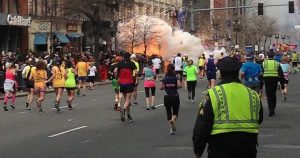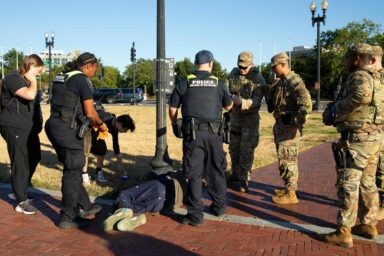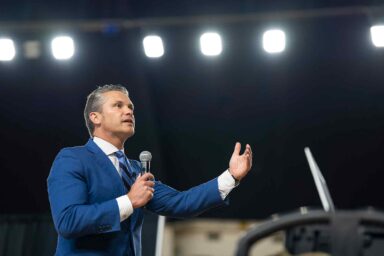Given the evidence presented in the Tsarnaev trial, it’s possible that Dzhokhar’s older brother, Tamerlan—who was killed by police in the immediate hours after the bombing—was an FBI informant.

We asked each member of our Boston Marathon Bombing reporting team to share their personal experience or perspective on one aspect of the bombing or the trial. Stay tuned for more personal perspectives like this as the trial concludes.
The entire defense of convicted Boston Marathon bomber Dzhokhar Tsarnaev was an effort to avoid the death penalty. Partly for that reason, no attempt was made to address the many unanswered questions surrounding the case, including one that could shed an entirely new light on many aspects of this case: Was Tamerlan Tsarnaev an FBI informant?
Last year, attorneys for Dzhokhar Tsarnaev argued in court motions that his older brother and alleged accomplice had been encouraged to become an FBI informant and report on the area’s Muslim and Chechen communities. As the trial drew near, US Circuit Court Judge George A. O’Toole limited the defense’s abilities to discuss in court Tamerlan’s role in the bombing. The discussion of whether Tamerlan was an informant was pushed to the dustbin of case files. It remains to be seen if it will once again appear in the upcoming sentencing phase.
For its part, the FBI has asserted that the Tsarnaev brothers were never sources for the agency nor did it attempt to recruit them as sources.
But, after recent independent investigations, it’s no longer the purview of skeptics to wonder about the true nature of the FBI’s involvement with two young, arguably down-on-their-luck Muslims hailing from a region—Chechnya—rife with turmoil.
In fact, the FBI commonly seeks out these types of young men for help as informants and to lead stings.
In the days leading up to jury deliberations in the Boston bombing trial—two New York women were arrested and charged with conspiracy to use weapons of mass destruction, citing the Boston Marathon bombings as inspiration. However, a criminal complaint revealed that an undercover law enforcement informant devised and facilitated the alleged plot. The complaint provided little evidence that the two women knew how to make a bomb before they were introduced to the informant.
The Informants
According to researcher Trevor Aaronson, author of The Terror Factory: Inside the FBI’s Manufactured War on Terrorism, nearly half of the 508 defendants prosecuted for terrorism-related incidents between 9/11 and 2011 were prompted to act by informants—who were paid as much as $100,000 per assignment. Sting operations resulted in the prosecutions of 158 defendants. Among the most high-profile plots of the last decade investigated by Aaronson, only three lacked FBI involvement.
Tamerlan was an out-of-work boxer, married to a nurse’s aide who worked 60 hours a week to make ends meet. How he could come up with $900 cash to send to his mother in Russia two days before the bombings—and afford to buy several backpacks, ammunition, BBs and other supposed bomb-making material—was never answered during the trial. Whether he participated in something illegal or earned the cash in some other manner was not explored.
Also noteworthy was the fact that of all the receipts the average person sticks into his or her wallet while shopping, the only receipts found in Tamerlan’s wallet were those that showed specifically his purchases of materials related to the bombings.
The Bombs
Another issue that was conspicuously glossed over during the trial was the sophistication of the Boylston Street bombs that killed three and maimed hundreds.

In court, defense attorneys presented copies of the Russian translation of the Inspire magazine [an Al Qaeda publication] that allegedly acted as the impetus for Tamerlan’s desire to build the bombs and carry out the attacks. The article’s authors included a notation that it was a “good article, but novices will not understand.” This underlined the complexity of the bombs.
The prosecution itself inadvertently advanced the notion of additional, unknown, parties playing a role in the bomb-making. When seeking to justify why FBI agents questioned Dzhokhar for two days before reading him his Miranda rights, the prosecution pointed to the sophistication of the bombs, which had led investigators to believe at the time there were others involved. If they ever explained how they came to determine that others weren’t—or how the brothers acquired that purported sophistication, we missed it.
***
If Tamerlan had made the bombs, one would expect to find at least traces on his premises. Yet the prosecution flip-flopped at least three times on the issue of whether any explosive black powder was found in Tamerlan’s apartment.
During the trial, the prosecution would selectively invoke the powder only when useful for proving that the brothers were the sole perpetrators of the bombing, thereby diverting public attention from the role others may have played in the attack.But when it serves the government’s purpose to raise the specter of imminent danger from shadowy accomplices, the explosive residue conveniently disappears. It reappears again when any hint of accomplices might aid the defense in warding off the death penalty.
The Trip
During the trial, much was also made of Tamerlan’s trip to Russia, from January 21 to July 17, 2012—but only in the context of how that trip may have been used to radicalize the elder Tsarnaev brother. While pre-trial motions and a US Senate investigation by the House Homeland Security Committee pointed to a Russian Federal Security Service (FSB in Russian) report requesting the CIA to investigate Tamerlan in 2011, the particulars of this investigation weren’t brought up in court.
The fact that Tamerlan was allowed to travel at all, despite allegedly appearing on a no-fly list, received little attention during the trial. WhoWhatWhy has long pondered this trip, along with Tamerlan’s dealings with a Canadian terrorist named William Plotnikov.
Tsarnaev family members, however, are adamant that Tamerlan spent most of his time with family, including a distant cousin named Magomed Kartashov, the founder and leader of a non-violent organization called Union of the Just, which often speaks out against US policies in the Muslim world. It seems strange that a person on track to bomb the marathon would associate with an organization concerned with non-violence.
The Others
An important potentially-related situation, almost completely ignored by traditional media outlets, was the relentless persecution, deportation and even killing of many of the Tsarnaev circle. Did this astonishing federal campaign result in any useful intelligence? If so, we haven’t learned of any. Or, was it for some other purpose? Some have charged that the harassment was explicitly accompanied by warnings that friends of the Tsarnaevs not talk to the press.
Three of Dzhokhar’s friends, Robel Phillipos, Dias Kadyrbayev, and Azamat Tazhayakov, were charged with a variety of federal offenses, including making false statements and obstruction of justice. His high school buddy, Stephen Silva, pleaded guilty to drug and gun charges, and then testified, in hopes of a reduced sentence, that he gave the brothers the gun used to kill MIT Officer Sean Collier.
Another of Tamerlan’s friends, Khairullozhon Matanov, pleaded guilty last month in federal court to misleading investigators. Yet another, Mustafa Ozseferoglu, is being threatened with deportation.
But the most high-profile of the brothers’ friends to meet with federal officers is Ibragim Todashev, who was shot and killed in his Orlando apartment by FBI officers after allegedly admitting that he and Tamerlan killed three of Tamerlan’s friends in what appeared to be drug deal gone wrong in 2011.
Todashev’s alleged confession did not match evidence found at the crime scene, and the events surrounding his death are the subject of a $30 million suit filed by his family last month.
That the federal government has so doggedly made sure that so many of the Tsarnaevs’ friends would be unable to speak out about the events surrounding the Boston Marathon bombing only raises more questions about what these young men knew about the Tsarnaevs’ involvement.
The Author
We’re not the only media entity with questions. Author and journalist Masha Gessen ponders the question of a cover-up in her book about the case, The Brothers: The Road to an American Tragedy, released on April 7. According to skeptical book reviewer Kevin Canfield, writing for the Kansas City Star:
“Gessen’s thinking goes like this: Because the FBI questioned Tamerlan Tsarnaev in 2011 and monitored him and his family, agents would have been likely to recognize him in surveillance camera images captured at the site of the bombing, which killed three and injured hundreds. Nonetheless, she writes, agents with the FBI’s Joint Terrorism Task Force didn’t initially identify the Tsarnaev brothers.
“A… logical explanation,” Gessen argues, “is that the person or persons who were in a position to recognize the brothers were consciously concealing this fact in order to protect their own or the agency’s reputation—either because it would look like the FBI had fumbled a solid investigative lead, causing tragedy, or worse, because the FBI had considered Tamerlan an informant.”
Even more incendiary is her suggestion that the FBI deliberately kept police at arm’s length as they were pursuing the brothers “because it needed to ensure that no other law enforcement got to Tamerlan Tsarnaev before the FBI had captured—or killed—him. In other words, the explanation that best fits the facts is a cover-up.”
If Dzhokhar takes the stand on his behalf during the sentencing phase of the trial, will the public learn more about his brother’s involvement with the Feds or with other sophisticated international entities? If he decides not to speak, will his defense argue the notion that, while his older brother influenced him, it was someone else who influenced Tamerlan?
Dzhokhar Tsarnaev’s attorneys have rested their case, admitted his guilt in opening and closing arguments and scuttled any attempt to use the trial as a truth-seeking mission. In effect, the defense has avoided anything that could offend the Boston-based jury in their bid to save his life. Yet questions still remain, and WhoWhatWhy remains committed to seeking answers.


